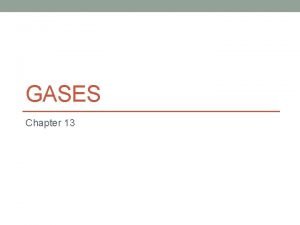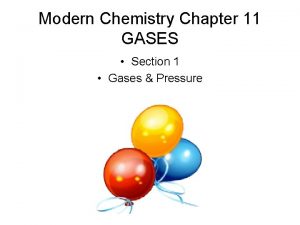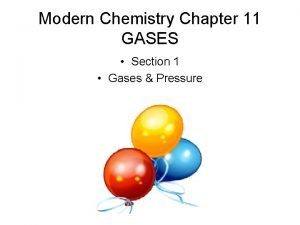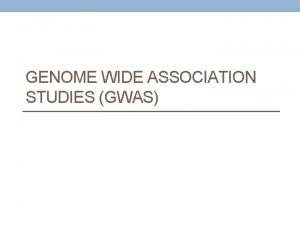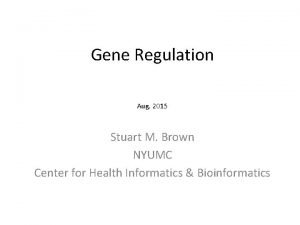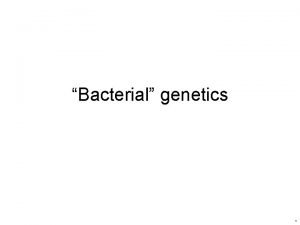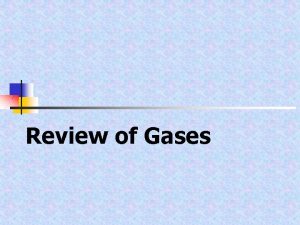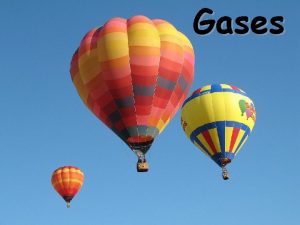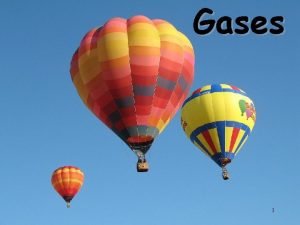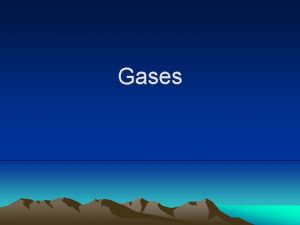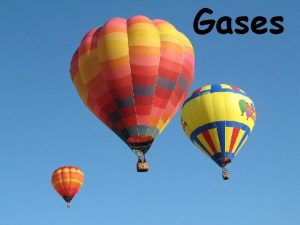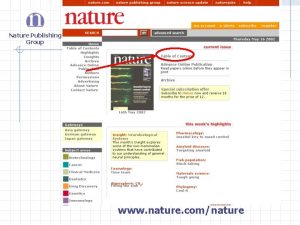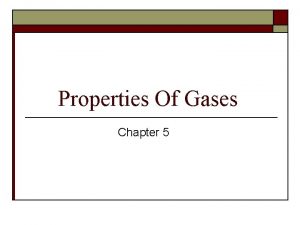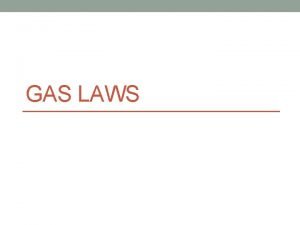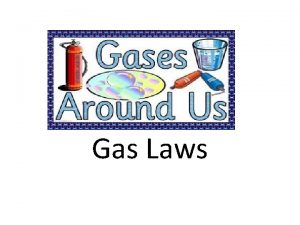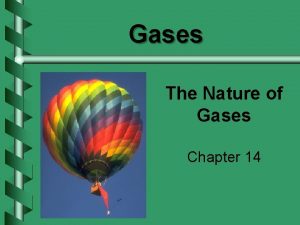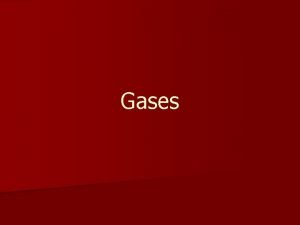Review of Gases The nature of gases Gases







































- Slides: 39

Review of Gases

The nature of gases… Gases all have common physical properties: 1) Mass 2) Easily compressible 3) Take the shape of their container 4) Can move through other gases 5) Exert pressure 6) Pressure depends on temperature

Postulates of K-M theory… 1) Gas consists of very small particles, each of which has a mass 2) Distances separating gas particles are relatively large 3) Gas particles are in constant, rapid, random motion 4) Collisions of gas particles with each other or container are perfectly elastic 5) Average kinetic energy of particles depends only on temperature of the gas 6) Gas particles exert no force on one another

Measuring Gases

Measuring gases… 4 variables: 1) Amount of gas (n) 2) Volume (V) 3) Temperature (T) 4) Pressure (P)

Measuring gases… Conversions: 1) 1 atm = 101. 3 k. Pa 2) 1 atm = 760 mm Hg 3) 1 atm = 760 torr 4) 1 bar = 100, 000 Pa 5) 1 bar = 0. 9869 atm

Measuring gases… Atmospheric pressure: • pressure of air around us • acts against pressure from inside object • varies with altitude

Measuring gases… Instruments to measure: • Mercury barometer

Measuring gases… Sample problem 1 A barometer has a column of mercury that is 745 mm in height. What is the atmospheric pressure in Pascals?

Measuring gases… Sample problem 2 The lowest recorded atmospheric pressure in the Western Hemisphere is 88. 86 k. Pa. What is this in mm Hg?

Measuring gases… Instruments to measure: • Mercury barometer • Manometer

Measuring gases… Sample problem 3: A balloon is attached to an open-ended manometer. The mercury level is 13 mm lower on the balloon side than the open side. The atmospheric pressure is 745 mm Hg. What is the pressure in the balloon?

Measuring gases… Sample problem 4: A closed container of gas is attached to a U-tube. The height of the open side is 27 mm lower than the closed side. The atmospheric pressure is 755 mm Hg. What is the pressure in the container?

Gas Laws Chapter 11

The gas laws… • A useful bit of information: Conditions for STP are 0. 00 C and 1. 00 atm

The gas laws… • Boyle’s Law – relationship between pressure & volume 1) formula: P 1 V 1 = P 2 V 2

Boyle’s Law Sample problem: A helium tank holds 25 L of He at 30. 0 atm, how many balloons can be filled if each balloon holds 2. 5 L at 1. 04 atm?

Boyle’s Law Sample problem: A gas at a pressure of 608 mm 3 Hg has a volume of 545 cm. The volume increases to 1065 cm 3. What is the new pressure?

The gas laws… • Charles’ Law – relationship between volume & temperature • formula: V 1/T 1 = V 2/T 2

Charles’ Law Sample problem: A gas has volume of 8. 57 L at 273 K. What is the volume at 355 K?

Charles’ Law Sample problem: A balloon has a volume of 1. 75 L at 25 C. At what Celsius temp would the volume be 1. 25 L?

The gas laws… • Avagadro’s Law – relationship between volume & amount of gas • formula: V = k 3 n

Avagadro’s Law Sample problem: What is the volume of 3. 6 moles of helium at STP?

Avagadro’s Law Sample problem: How many moles of gas are in 593 L at STP?

The gas laws… • Dalton’s Law of Partial Pressures – relates pressures of gases in a mixture • formula: Ptot = pa + pb + pc + …

Dalton’s Law of Partial Pressures Sample problem: What is the atmospheric pressure if the partial pressures of nitrogen, oxygen and argon are 604. 5 mm Hg, 162. 8 mm Hg, and 0. 5 mm Hg respectively?

Dalton’s Law of Partial Pressures Sample problem: A person using an oxygen mask is breathing air with 33 % oxygen. What is the partial pressure of O 2 if the total air pressure is 110 k. Pa?

Dalton’s Law of Partial Pressures Sample problem: The gases CO 2, Ne, and Kr are in a container. Each gas has the same partial pressure. The total pressure is 33, 500 Pa. What is the partial pressure of N 2?

Combined Gas Law

The gas laws… • The combined gas law – relates pressure, volume, and temperature (may use in place of Boyle’s and/or Charles’ Law) • formula: (P 1 V 1) = (P 2 V 2) T 1 T 2

The combined gas law Sample Problem: • The volume of a gas-filled balloon is 30. 0 L at 40. C and 153 k. Pa. What volume will the balloon have at STP?

The combined gas law… Sample Problem: • A gas occupies a volume of 159. 1 m. L at 316 K and 4. 89 atm. What volume will it occupy at STP?

Ideal Gases

The ideal gas law… • Relates pressure, temperature, volume, and moles

The ideal gas law… • Formula: PV = n. RT R is a constant R = 0. 0821 (atm×L)/(mol×K)

The ideal gas law… Relates to K-M theory • P increases as n increases (while V & T are constant) • P increases as T increases (while n & V are constant) • P increases as V decreases (while n & T are constant)

The ideal gas law… Does not work for… • Very high pressures • Very low temperatures

The ideal gas law… Sample Problem 1: • How many moles of a gas at 100. °C are needed to fill a 1. 00 L flask at a pressure of 1. 50 atm?

The ideal gas law… Sample Problem 2: • What is the volume occupied by 9. 45 g of C 2 H 2 at STP?
 State boyle’s law.
State boyle’s law. Nature and nature's laws lay hid in night meaning
Nature and nature's laws lay hid in night meaning Determinace lidské psychiky
Determinace lidské psychiky Chapter 11 review gases section 1
Chapter 11 review gases section 1 Chapter 11 review gases section 1
Chapter 11 review gases section 1 Nature review genetics
Nature review genetics Nature review genetics
Nature review genetics Gwas method
Gwas method Nature review genetics
Nature review genetics Nature review genetics
Nature review genetics Nature review genetics
Nature review genetics Hát kết hợp bộ gõ cơ thể
Hát kết hợp bộ gõ cơ thể Slidetodoc
Slidetodoc Bổ thể
Bổ thể Tỉ lệ cơ thể trẻ em
Tỉ lệ cơ thể trẻ em Chó sói
Chó sói Glasgow thang điểm
Glasgow thang điểm Alleluia hat len nguoi oi
Alleluia hat len nguoi oi Các môn thể thao bắt đầu bằng tiếng bóng
Các môn thể thao bắt đầu bằng tiếng bóng Thế nào là hệ số cao nhất
Thế nào là hệ số cao nhất Các châu lục và đại dương trên thế giới
Các châu lục và đại dương trên thế giới Cong thức tính động năng
Cong thức tính động năng Trời xanh đây là của chúng ta thể thơ
Trời xanh đây là của chúng ta thể thơ Mật thư anh em như thể tay chân
Mật thư anh em như thể tay chân Phép trừ bù
Phép trừ bù Phản ứng thế ankan
Phản ứng thế ankan Các châu lục và đại dương trên thế giới
Các châu lục và đại dương trên thế giới Thể thơ truyền thống
Thể thơ truyền thống Quá trình desamine hóa có thể tạo ra
Quá trình desamine hóa có thể tạo ra Một số thể thơ truyền thống
Một số thể thơ truyền thống Cái miệng xinh xinh thế chỉ nói điều hay thôi
Cái miệng xinh xinh thế chỉ nói điều hay thôi Vẽ hình chiếu vuông góc của vật thể sau
Vẽ hình chiếu vuông góc của vật thể sau Biện pháp chống mỏi cơ
Biện pháp chống mỏi cơ đặc điểm cơ thể của người tối cổ
đặc điểm cơ thể của người tối cổ V cc cc
V cc cc Vẽ hình chiếu đứng bằng cạnh của vật thể
Vẽ hình chiếu đứng bằng cạnh của vật thể Vẽ hình chiếu vuông góc của vật thể sau
Vẽ hình chiếu vuông góc của vật thể sau Thẻ vin
Thẻ vin đại từ thay thế
đại từ thay thế điện thế nghỉ
điện thế nghỉ
